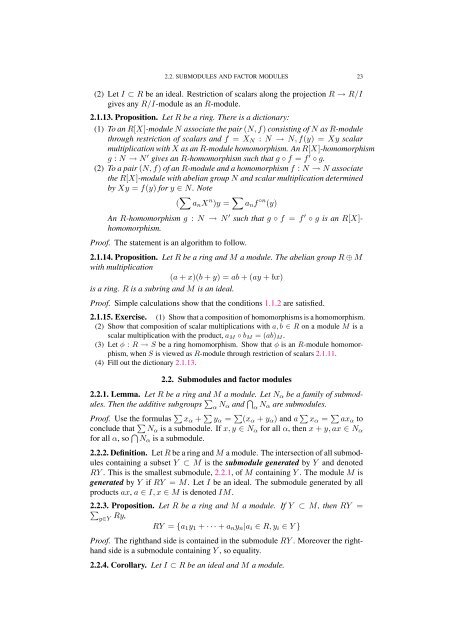Commutative algebra - Department of Mathematical Sciences - old ...
Commutative algebra - Department of Mathematical Sciences - old ...
Commutative algebra - Department of Mathematical Sciences - old ...
Create successful ePaper yourself
Turn your PDF publications into a flip-book with our unique Google optimized e-Paper software.
2.2. SUBMODULES AND FACTOR MODULES 23<br />
(2) Let I ⊂ R be an ideal. Restriction <strong>of</strong> scalars along the projection R → R/I<br />
gives any R/I-module as an R-module.<br />
2.1.13. Proposition. Let R be a ring. There is a dictionary:<br />
(1) To an R[X]-module N associate the pair (N, f) consisting <strong>of</strong> N as R-module<br />
through restriction <strong>of</strong> scalars and f = XN : N → N, f(y) = Xy scalar<br />
multiplication with X as an R-module homomorphism. An R[X]-homomorphism<br />
g : N → N ′ gives an R-homomorphism such that g ◦ f = f ′ ◦ g.<br />
(2) To a pair (N, f) <strong>of</strong> an R-module and a homomorphism f : N → N associate<br />
the R[X]-module with abelian group N and scalar multiplication determined<br />
by Xy = f(y) for y ∈ N. Note<br />
( anX n )y = anf ◦n (y)<br />
An R-homomorphism g : N → N ′ such that g ◦ f = f ′ ◦ g is an R[X]homomorphism.<br />
Pro<strong>of</strong>. The statement is an algorithm to follow.<br />
2.1.14. Proposition. Let R be a ring and M a module. The abelian group R ⊕ M<br />
with multiplication<br />
(a + x)(b + y) = ab + (ay + bx)<br />
is a ring. R is a subring and M is an ideal.<br />
Pro<strong>of</strong>. Simple calculations show that the conditions 1.1.2 are satisfied.<br />
2.1.15. Exercise. (1) Show that a composition <strong>of</strong> homomorphisms is a homomorphism.<br />
(2) Show that composition <strong>of</strong> scalar multiplications with a, b ∈ R on a module M is a<br />
scalar multiplication with the product, aM ◦ bM = (ab)M .<br />
(3) Let φ : R → S be a ring homomorphism. Show that φ is an R-module homomorphism,<br />
when S is viewed as R-module through restriction <strong>of</strong> scalars 2.1.11.<br />
(4) Fill out the dictionary 2.1.13.<br />
2.2. Submodules and factor modules<br />
2.2.1. Lemma. Let R be a ring and M a module. Let Nα be a family <strong>of</strong> submodules.<br />
Then the additive subgroups <br />
α Nα and <br />
α Nα are submodules.<br />
Pro<strong>of</strong>. Use the formulas xα + yα = (xα + yα) and a xα = axα to<br />
conclude that Nα is a submodule. If x, y ∈ Nα for all α, then x + y, ax ∈ Nα<br />
for all α, so Nα is a submodule.<br />
2.2.2. Definition. Let R be a ring and M a module. The intersection <strong>of</strong> all submodules<br />
containing a subset Y ⊂ M is the submodule generated by Y and denoted<br />
RY . This is the smallest submodule, 2.2.1, <strong>of</strong> M containing Y . The module M is<br />
generated by Y if RY = M. Let I be an ideal. The submodule generated by all<br />
products ax, a ∈ I, x ∈ M is denoted IM.<br />
2.2.3. Proposition. Let R be a ring and M a module. If Y ⊂ M, then RY =<br />
<br />
y∈Y Ry,<br />
RY = {a1y1 + · · · + anyn|ai ∈ R, yi ∈ Y }<br />
Pro<strong>of</strong>. The righthand side is contained in the submodule RY . Moreover the righthand<br />
side is a submodule containing Y , so equality.<br />
2.2.4. Corollary. Let I ⊂ R be an ideal and M a module.
















